
An otherwise healthy 40-year-old woman presented with a rash on her forehead and nose and erythema of her right eye. The rash had appeared 2 days earlier and was asymptomatic.
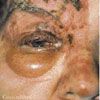

An otherwise healthy 40-year-old woman presented with a rash on her forehead and nose and erythema of her right eye. The rash had appeared 2 days earlier and was asymptomatic.

These painful eczematous lesionsat the angle of the mouth and thebase of the nostrils had been presentin a 52-year-old woman for 3days (A). Some of the vesicles hadulcerated and left a crust over theregion. The patient said she had hadsimilar attacks in the past. The diagnosisof recurrent herpes simplexvirus 1 (HSV-1) infection was made.The patient was treated with acyclovirfor 1 week, and all the lesionsdisappeared.

A 30-year-old man has had painful genital lesions for the pastseveral days. He recently returned from a business trip during which hehad several unprotected sexual encounters.
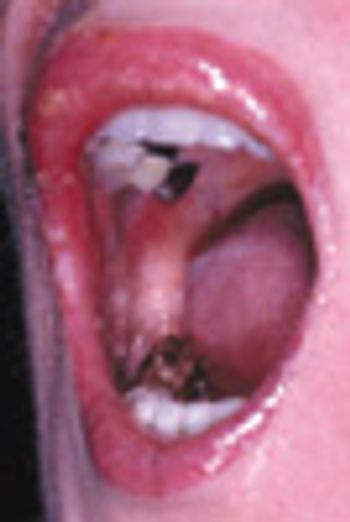
A 65-year-old woman sought evaluation of a unilateral, asymptomatic rash that involved the oral mucosa and lips. The rash consisted of ulcerations and vesicles. The suspected diagnosis of herpes zoster was confirmed 4 days later when the patient experienced lancinating pain throughout the affected area and into her scalp and neck.
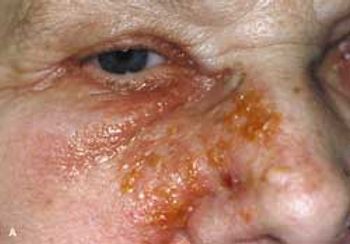
For a few days, this 73-year-old woman had had an itchy, painful rash on the right side of her face. Despite its proximity to her eye, she had no ocular involvement and no blurring of vision.
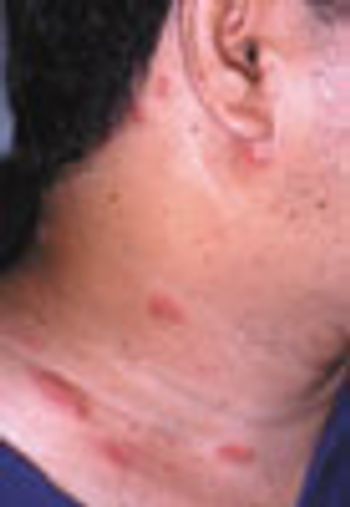
For 3 days, a 44-year-old man had several crops of tiny vesicles with raised erythematous bases on the right side of his neck and 2 elongated maculopapular lesions at the base of the neck. All of the lesions were within the C3 dermatome.
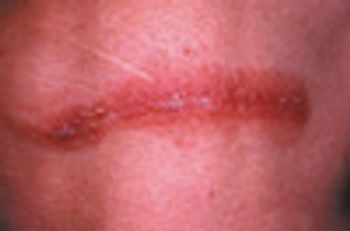
A painful rash suddenly developed on the chest wall of an otherwise healthy 8-year-old girl. Examination of the rash revealed grouped vesicles with an erythematous base in a linear distribution along the T5 dermatome. The child had not been vaccinated with varicella vaccine and had had chickenpox 3 years earlier.
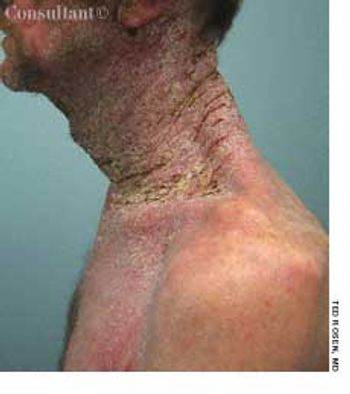
A52-year-old white man presented with a pruritic eruption on the neck of 3 months’ duration. The rash had not responded to a potent topical corticosteroid prescribed by another practitioner for the presumed diagnosis of eczema. The patient reported no current health problems. His history included a pubic louse infestation and several episodes of uncomplicated urethral gonorrhea. He readily admitted to having unprotected sexual intercourse with prostitutes.

For 3 months, a 50-year-old man had been bothered by a worsening and spreading rash on his feet and lower legs. The multiple, nodular, fungating lesions were nonpruritic. The heterosexual, unmarried patient did not use intravenous drugs and did not know his HIV status; he denied any significant medical history.

A 34-year-old woman presented with a3-day history of painful blisters of theupper lip and nose. Five days earlier,a rapid antigen test had confirmedstreptococcal pharyngitis; amoxicillinwas prescribed. The patient had nohistory of herpes and was immunocompetent.She had several youngchildren and did not work outsidethe home.

A 34-year-old woman (gravida 3, para 2) presented at 28 weeks’ gestation with a 3-week history of a pruritic rash that had progressively worsened. Multiple vesicles and bullae were noted; erosions and crusts on older lesions were also present. The patient had had no prodromal symptoms; she denied fever, chills, nausea, and vomiting. The purplish hue on her body resulted from application of the topical antibacterial agent, gentian violet, which the patient had obtained in Mexico.
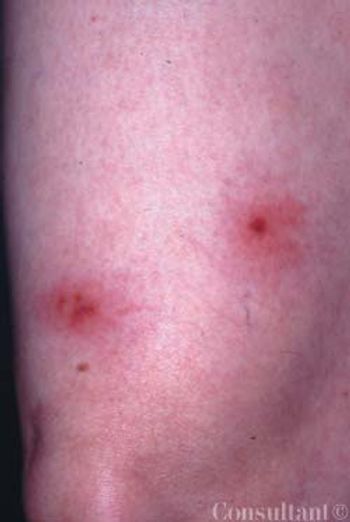
Several lesions had appeared 1 week earlier on the left distal thigh of a 47-year-old woman. The affected area featured erythema with irregular faded borders and central redness with very fine papules over the L3 dermatome. The indurated and tender central areas suggested inflammation or necrosis. There were no vesicles and there was no drainage.

What are the appropriate laboratory tests for an infant whose mother has hepatitisC virus (HCV) infection?

A 32-year-old previously healthywoman presents to the emergencydepartment with skin lesions, suprapubicpain, and generalized myalgia of1 week’s duration. Trimethoprim-sulfamethoxazolefor a presumed urinarytract infection is prescribed, and thepatient is discharged. The symptomspersist; she is hospitalized 2 days later.

The most common blood-borne infection in the United States, hepatitis C is also one of the leading causes of chronic liver disease in this country. About 35,000 new hepatitis C virus (HCV) infections are diagnosed each year; by 2015, the number of persons with documented HCV infection is expected to have increased 4-fold from what it was in 1990.

A 24-year-old woman's firstpregnancy was uneventful until thesixth month when mild malaise and ahighly pruritic abdominal rash occurred(Figure 1). A biopsy and directimmunofluorescence confirmedthe suspected diagnosis of herpesgestationis.

Although many patients with primary HSV-1 infection have no clinicalrecurrences, the failure to seroconvert occurs very seldom-inno more than 1% of patients.

Which treatment approaches are effective in a woman who has persistent or refractory vaginal trichomoniasis? Should the male sex partner of a patient who has recurrent vulvovaginal candidiasis be treated? Answers to these and other questions can be found in the recently updated CDC guidelines on managing sexually transmitted diseases

Recently the CDC updated its guidelines for treating sexually transmitted diseases (STDs). This article focuses on genital herpes simplex virus (HSV) infection and human papillomavirus (HPV) infection.
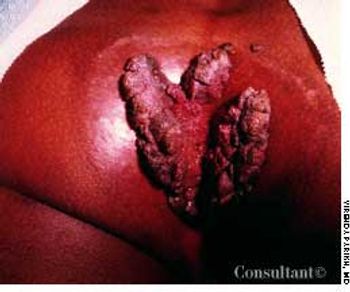
24-year-old woman had experienced perianal itching and a small amount of rectal bleeding for 6 months. She also complained of a perianal protrusion.